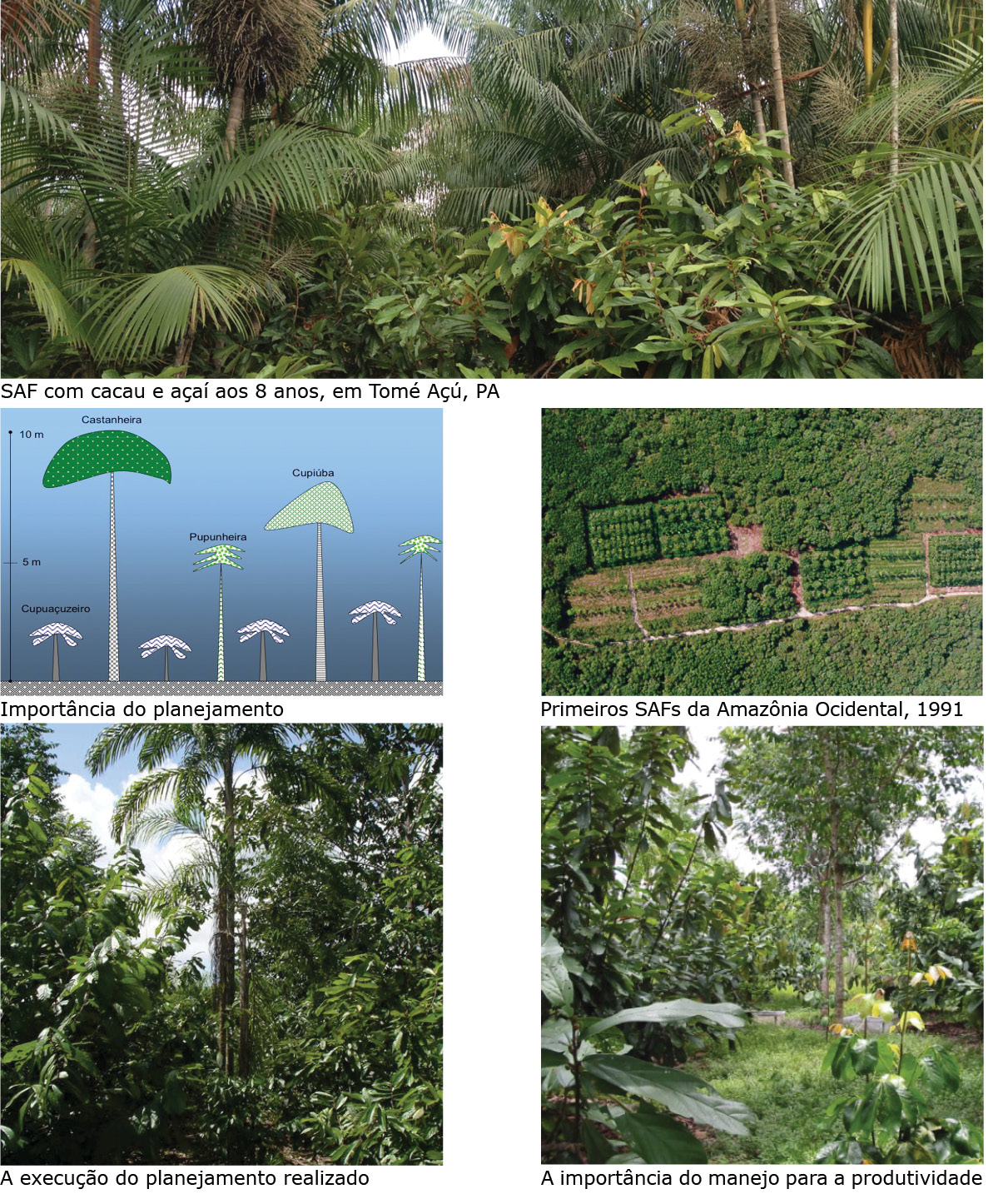Marcelo Francia Arco-Verde
Pesquisador da Embrapa Florestas
OpCP74
Silvicultura e sistemas agroflorestais
Sistemas Agroflorestais (SAFs) são sistemas de produção onde espécies arbóreas são plantadas em conjunto com outras culturas (agrícolas, hortaliças ou frutíferas) e/ou animais.
Representam uma abordagem inovadora e promissora para enfrentar os desafios enfrentados pela agricultura contemporânea e para contribuir para a restauração florestal. Apesar de desafios específicos, as vantagens significativas em termos de sustentabilidade ambiental, resiliência agrícola e benefícios econômicos destacam o potencial dos SAFs como uma importante ferramenta na construção de um futuro mais sustentável. A integração de práticas agroflorestais deve ser incentivada e adaptada para atender às necessidades específicas de diferentes regiões e comunidades.
O sucesso dos SAFs reside na compreensão das habilidades, experiências e metas individuais dos agricultores. Uma avaliação das aptidões e interesses é essencial para moldar estratégias que se alinhem com as características únicas de cada produtor. O envolvimento direto dos agricultores no planejamento é fundamental, garantindo que as decisões reflitam as necessidades e desejos individuais. Isso promove aceitação e comprometimento.
A assistência técnica é essencial e desempenha o papel de oferecer orientação e capacitação, além de acompanhar a implantação e manutenção das atividades dos SAFs. Dessa forma, os agricultores podem realizar ajustes, conforme necessário, garantindo a eficácia e sustentabilidade ao longo do tempo.
 Podemos mencionar que as principais vantagens dos SAFs são:
Podemos mencionar que as principais vantagens dos SAFs são:
1) diversificação de cultivos: incluindo alimentos, frutíferas, produtos madeireiros e não madeireiros. Essa diversidade pode complicar a comercialização, uma vez que diferentes produtos podem ter demandas de mercado distintas;
2) conservação do solo: a presença de árvores em sistemas agroflorestais ajuda a prevenir a erosão do solo, protegendo-o contra a degradação;
3) ciclagem de nutrientes: a interação entre as árvores e as culturas cria um ciclo de nutrientes mais eficiente, reduzindo a necessidade de fertilizantes químicos;
4) sequestro de carbono: as árvores armazenam carbono em sua biomassa, contribuindo para mitigar as mudanças climáticas e promovendo a sustentabilidade ambiental;
5) resiliência a mudanças climáticas: a diversificação de culturas e a presença de árvores conferem maior resiliência aos agricultores diante das mudanças climáticas. Os SAFs são capazes de se adaptar melhor a condições adversas, contribuindo para a estabilidade da produção.;
6) diversificação de renda: a presença de árvores de valor comercial em sistemas agroflorestais oferece oportunidades de diversificação de renda para os agricultores;
7) envolvimento comunitário: promovem a participação ativa da comunidade na gestão e manutenção dos sistemas. Agricultores tornam-se co-criadores do ambiente agroflorestal, fortalecendo os laços comunitários e incentivando a responsabilidade compartilhada;
8) acesso a mercados sustentáveis: produtos provenientes de SAFs, muitas vezes cultivados de forma sustentável e orgânica, podem atrair consumidores conscientes. Agricultores envolvidos em SAFs têm a oportunidade de acessar mercados diferenciados e obter preços mais altos para seus produtos.
E as principais dificuldades para adotar SAFs são:
1) conhecimento específico e complexidade de manejo: a gestão de sistemas agroflorestais pode ser mais complexa em comparação com práticas agrícolas convencionais, demanda conhecimento técnico específico, desde o planejamento até a manutenção, sendo necessário conhecimento mais amplo e habilidades específicas para otimizar a interação entre as diferentes espécies. A capacitação técnica é essencial para capacitar os agricultores na implementação e gestão
Representam uma abordagem inovadora e promissora para enfrentar os desafios enfrentados pela agricultura contemporânea e para contribuir para a restauração florestal. Apesar de desafios específicos, as vantagens significativas em termos de sustentabilidade ambiental, resiliência agrícola e benefícios econômicos destacam o potencial dos SAFs como uma importante ferramenta na construção de um futuro mais sustentável. A integração de práticas agroflorestais deve ser incentivada e adaptada para atender às necessidades específicas de diferentes regiões e comunidades.
O sucesso dos SAFs reside na compreensão das habilidades, experiências e metas individuais dos agricultores. Uma avaliação das aptidões e interesses é essencial para moldar estratégias que se alinhem com as características únicas de cada produtor. O envolvimento direto dos agricultores no planejamento é fundamental, garantindo que as decisões reflitam as necessidades e desejos individuais. Isso promove aceitação e comprometimento.
A assistência técnica é essencial e desempenha o papel de oferecer orientação e capacitação, além de acompanhar a implantação e manutenção das atividades dos SAFs. Dessa forma, os agricultores podem realizar ajustes, conforme necessário, garantindo a eficácia e sustentabilidade ao longo do tempo.
 Podemos mencionar que as principais vantagens dos SAFs são:
Podemos mencionar que as principais vantagens dos SAFs são:1) diversificação de cultivos: incluindo alimentos, frutíferas, produtos madeireiros e não madeireiros. Essa diversidade pode complicar a comercialização, uma vez que diferentes produtos podem ter demandas de mercado distintas;
2) conservação do solo: a presença de árvores em sistemas agroflorestais ajuda a prevenir a erosão do solo, protegendo-o contra a degradação;
3) ciclagem de nutrientes: a interação entre as árvores e as culturas cria um ciclo de nutrientes mais eficiente, reduzindo a necessidade de fertilizantes químicos;
4) sequestro de carbono: as árvores armazenam carbono em sua biomassa, contribuindo para mitigar as mudanças climáticas e promovendo a sustentabilidade ambiental;
5) resiliência a mudanças climáticas: a diversificação de culturas e a presença de árvores conferem maior resiliência aos agricultores diante das mudanças climáticas. Os SAFs são capazes de se adaptar melhor a condições adversas, contribuindo para a estabilidade da produção.;
6) diversificação de renda: a presença de árvores de valor comercial em sistemas agroflorestais oferece oportunidades de diversificação de renda para os agricultores;
7) envolvimento comunitário: promovem a participação ativa da comunidade na gestão e manutenção dos sistemas. Agricultores tornam-se co-criadores do ambiente agroflorestal, fortalecendo os laços comunitários e incentivando a responsabilidade compartilhada;
8) acesso a mercados sustentáveis: produtos provenientes de SAFs, muitas vezes cultivados de forma sustentável e orgânica, podem atrair consumidores conscientes. Agricultores envolvidos em SAFs têm a oportunidade de acessar mercados diferenciados e obter preços mais altos para seus produtos.
E as principais dificuldades para adotar SAFs são:
1) conhecimento específico e complexidade de manejo: a gestão de sistemas agroflorestais pode ser mais complexa em comparação com práticas agrícolas convencionais, demanda conhecimento técnico específico, desde o planejamento até a manutenção, sendo necessário conhecimento mais amplo e habilidades específicas para otimizar a interação entre as diferentes espécies. A capacitação técnica é essencial para capacitar os agricultores na implementação e gestão
eficaz de SAFs. Programas de treinamento e assistência técnica podem ajudar a superar as barreiras relacionadas ao conhecimento;
2) tempo de estabelecimento: a transição de sistemas agrícolas convencionais para SAFs pode demandar tempo, já que as árvores precisam de um período para amadurecer e começar a oferecer benefícios significativos;
3) concorrência por recursos: a competição por luz, água e nutrientes entre árvores e plantas cultivadas pode ocorrer, especialmente durante os estágios iniciais do sistema;
4) comercialização: a comercialização de produtos agroflorestais pode ser mais desafiadora devido à diversidade de produtos e à necessidade de encontrar mercados específicos. A falta de cadeias de suprimentos consolidadas pode representar um desafio para os agricultores.
A formação de cooperativas permite que os agricultores unam forças na comercialização de produtos agroflorestais. A cooperação facilita a negociação de preços mais justos e a entrada em mercados maiores. As certificações podem valorizar os produtos agroflorestais. Agricultores certificados podem acessar mercados que valorizam a sustentabilidade, promovendo práticas agrícolas responsáveis.
Os SAFs, quando integrados com a participação ativa dos agricultores e estratégias eficazes de comercialização, oferecem uma solução holística para os desafios enfrentados pela agricultura moderna. Ao proporcionar benefícios econômicos e sociais, os SAFs não apenas fortalecem a resiliência dos agricultores, mas também contribuem para a restauração florestal e a construção de sistemas alimentares mais sustentáveis e inclusivos.
O caminho para a adoção generalizada de SAFs passa pela capacitação dos agricultores, cooperação comunitária e a criação de mercados sustentáveis que valorizem a diversidade e a sustentabilidade.
A viabilidade financeira dos SAFs requer uma abordagem holística, incorporando estratégias que abordem desafios específicos. A diversificação inteligente, a integração eficiente nas cadeias de valor, a busca de certificações adequadas e a adoção de tecnologias inovadoras são fundamentais para garantir o sucesso econômico a longo prazo. Ao alinhar práticas sustentáveis com estratégias financeiras sólidas, os agricultores podem colher os benefícios econômicos e ambientais dos SAFs.
A superação dos desafios de comercialização em sistemas agroflorestais exige uma abordagem multifacetada que envolva produtores, consumidores, governos e parceiros comerciais. Ao focar em estratégias que abordem a diversidade de produtos, a falta de cadeias de suprimentos consolidadas e a conscientização do consumidor, os agricultores em SAFs podem fortalecer suas posições no mercado. Além disso, medidas como certificação acessível, estratégias de marketing inovadoras e parcerias estratégicas podem contribuir para criar um ambiente comercial mais favorável para produtos agroflorestais, incentivando assim a transição para práticas agrícolas mais sustentáveis.
2) tempo de estabelecimento: a transição de sistemas agrícolas convencionais para SAFs pode demandar tempo, já que as árvores precisam de um período para amadurecer e começar a oferecer benefícios significativos;
3) concorrência por recursos: a competição por luz, água e nutrientes entre árvores e plantas cultivadas pode ocorrer, especialmente durante os estágios iniciais do sistema;
4) comercialização: a comercialização de produtos agroflorestais pode ser mais desafiadora devido à diversidade de produtos e à necessidade de encontrar mercados específicos. A falta de cadeias de suprimentos consolidadas pode representar um desafio para os agricultores.
A formação de cooperativas permite que os agricultores unam forças na comercialização de produtos agroflorestais. A cooperação facilita a negociação de preços mais justos e a entrada em mercados maiores. As certificações podem valorizar os produtos agroflorestais. Agricultores certificados podem acessar mercados que valorizam a sustentabilidade, promovendo práticas agrícolas responsáveis.
Os SAFs, quando integrados com a participação ativa dos agricultores e estratégias eficazes de comercialização, oferecem uma solução holística para os desafios enfrentados pela agricultura moderna. Ao proporcionar benefícios econômicos e sociais, os SAFs não apenas fortalecem a resiliência dos agricultores, mas também contribuem para a restauração florestal e a construção de sistemas alimentares mais sustentáveis e inclusivos.
O caminho para a adoção generalizada de SAFs passa pela capacitação dos agricultores, cooperação comunitária e a criação de mercados sustentáveis que valorizem a diversidade e a sustentabilidade.
A viabilidade financeira dos SAFs requer uma abordagem holística, incorporando estratégias que abordem desafios específicos. A diversificação inteligente, a integração eficiente nas cadeias de valor, a busca de certificações adequadas e a adoção de tecnologias inovadoras são fundamentais para garantir o sucesso econômico a longo prazo. Ao alinhar práticas sustentáveis com estratégias financeiras sólidas, os agricultores podem colher os benefícios econômicos e ambientais dos SAFs.
A superação dos desafios de comercialização em sistemas agroflorestais exige uma abordagem multifacetada que envolva produtores, consumidores, governos e parceiros comerciais. Ao focar em estratégias que abordem a diversidade de produtos, a falta de cadeias de suprimentos consolidadas e a conscientização do consumidor, os agricultores em SAFs podem fortalecer suas posições no mercado. Além disso, medidas como certificação acessível, estratégias de marketing inovadoras e parcerias estratégicas podem contribuir para criar um ambiente comercial mais favorável para produtos agroflorestais, incentivando assim a transição para práticas agrícolas mais sustentáveis.




